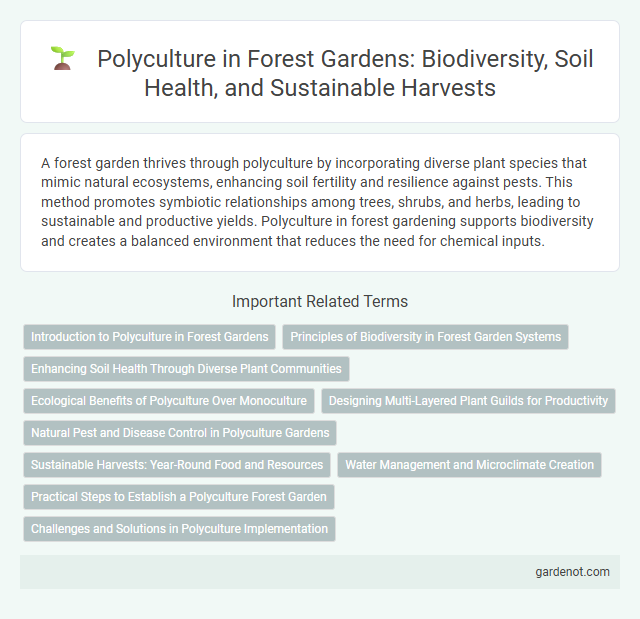A forest garden thrives through polyculture by incorporating diverse plant species that mimic natural ecosystems, enhancing soil fertility and resilience against pests. This method promotes symbiotic relationships among trees, shrubs, and herbs, leading to sustainable and productive yields. Polyculture in forest gardening supports biodiversity and creates a balanced environment that reduces the need for chemical inputs.
Introduction to Polyculture in Forest Gardens
Polyculture in forest gardens involves cultivating multiple plant species together to mimic natural ecosystems, enhancing biodiversity and resilience. This method improves soil health through diverse root systems and promotes natural pest control by attracting beneficial insects. Integrating a variety of trees, shrubs, and ground covers creates sustainable food webs and supports long-term ecosystem stability.
Principles of Biodiversity in Forest Garden Systems
Polyculture in forest garden systems promotes biodiversity by incorporating a diverse range of plant species that function synergistically to enhance ecosystem resilience and productivity. Key principles include spatial and temporal diversity, the integration of nitrogen-fixing plants to improve soil fertility, and the creation of multi-layered vegetation structures to maximize habitat niches. This biodiversity not only supports pest control and soil health but also ensures sustainable yields and ecological balance.
Enhancing Soil Health Through Diverse Plant Communities
Polycuture systems in forest gardens enhance soil health by fostering diverse plant communities that improve nutrient cycling and increase microbial activity. This biodiversity promotes natural pest control and supports the proliferation of beneficial fungi and bacteria, leading to richer organic matter and improved soil structure. Integrating multiple plant species creates synergistic interactions that boost soil fertility and resilience against erosion and degradation.
Ecological Benefits of Polyculture Over Monoculture
Polyculture enhances biodiversity by integrating diverse plant species, which improves soil health and reduces pest outbreaks compared to monoculture systems. This ecological diversification supports natural pest control and nutrient cycling, leading to increased resilience against diseases and environmental stressors. Forest gardens employing polyculture practices contribute to sustainable agroecosystems by mimicking natural forest structures and promoting ecosystem stability.
Designing Multi-Layered Plant Guilds for Productivity
Polycuture in forest garden design enhances productivity by integrating multi-layered plant guilds that mimic natural ecosystems, combining trees, shrubs, herbs, and groundcovers for efficient space use and resource sharing. Strategic layering improves nutrient cycling, pest control, and microclimate moderation, fostering resilient plant communities with increased yields. Emphasizing diverse species selection and functional roles optimizes photosynthesis, soil health, and water retention, driving sustainable productivity in forest gardens.
Natural Pest and Disease Control in Polyculture Gardens
Polyculture gardens enhance natural pest and disease control by promoting biodiversity, which attracts beneficial insects and predators that suppress harmful pests. Diverse plant species create habitats that disrupt pest life cycles and reduce the spread of diseases compared to monocultures. Integrating companion plants like marigolds and basil further strengthens pest resistance, minimizing the need for chemical interventions.
Sustainable Harvests: Year-Round Food and Resources
A polyculture forest garden maximizes sustainable harvests by integrating diverse plant species that produce food and resources throughout the year, ensuring continuous yield without depleting soil nutrients. Combining fruit trees, nitrogen-fixing shrubs, perennial vegetables, and medicinal plants creates a resilient ecosystem that supports biodiversity and reduces pest pressure naturally. This agroforestry approach enhances carbon sequestration and improves water retention, promoting long-term environmental health alongside consistent food production.
Water Management and Microclimate Creation
Polyculture in forest gardens enhances water management by promoting diverse root structures that improve soil infiltration and reduce runoff, thus conserving moisture. This biodiversity creates a self-regulating microclimate, stabilizing temperature and humidity levels essential for plant health. The interplay of various plant species also supports natural water cycling, increasing resilience to drought and flooding.
Practical Steps to Establish a Polyculture Forest Garden
Selecting diverse native tree species with complementary growth patterns enhances resource use efficiency and promotes ecosystem resilience in a polyculture forest garden. Implementing layered planting, including ground covers, shrubs, and canopy trees, maximizes vertical space and supports biodiversity. Regular monitoring of soil health and adaptive management practices ensure sustainable productivity and long-term stability.
Challenges and Solutions in Polyculture Implementation
Polyculture implementation in forest gardens faces challenges such as competition for light, nutrients, and water among diverse species, leading to imbalanced growth and reduced yields. Managing species selection and spatial arrangement through agroforestry design can mitigate resource competition by optimizing complementary interactions and niche partitioning. Employing adaptive management practices like soil amendment, mulching, and pruning further enhances system resilience and productivity in polyculture settings.
Polycuture Infographic

 gardenot.com
gardenot.com